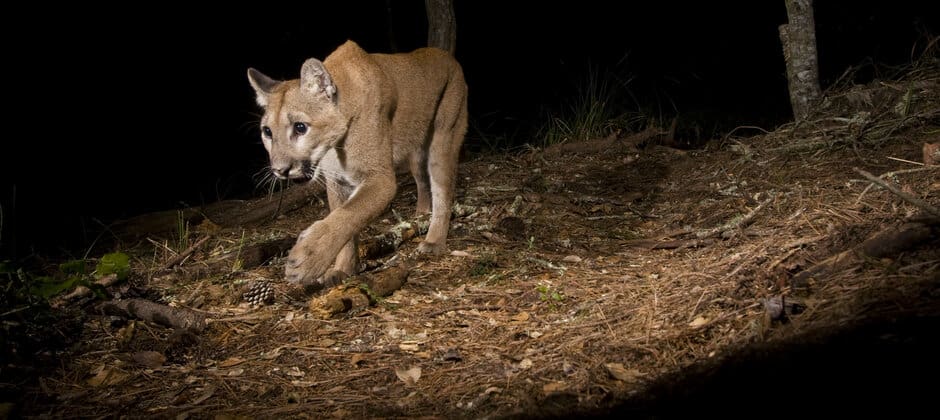Share this article
More people means smaller home ranges for pumas
Pumas’ fear of humans causes them to spend more energy avoiding them, which could ultimately reduce the sizes of their home ranges.
“We know that humans impact mountain lions and other wildlife in different ways,” said TWS member Chris Wilmers, a wildlife professor at the University of California Santa Cruz. “If pumas are avoiding people, does that impose costs on pumas in terms of lower fitness?”
Wilmers is the senior author of a study published in the Proceedings of the National Academy of Sciences in which he and his colleagues tracked the movement and energy expelled by pumas in Santa Cruz. The species is now provisionally listed as a state threatened species, and Wilmers said animals like pumas with large space requirements are likely to be impacted first by human development.
“As we develop the landscape, we’re increasingly constraining these animals to smaller and smaller spaces,” he said.
To test out mountain lions’ energy expenditure, Wilmers and his colleagues fit the big cats with accelerometer collars, devices that work like Fitbits that people wear on their wrists to track their exercise and movements. The team first needed to calibrate the collars in the lab to see how the accelerometers responded to certain mountain lion behaviors. They did this by having mountain lions walk and run on treadmills enclosed in Plexiglass. The shaking of the collar allowed them to estimate how many calories the animals were burning. “This nice relationship we can then use in the field,” he said.
The team then collared five adult females and eight adult males with tracking collars equipped with accelerometers and let them roam their natural habitats. For two months, the collars recorded GPS and accelerometer data.
When they retrieved the data, they wanted to see what was causing them to burn more energy — the physical landscape such as more rugged terrain or fear of humans and being close to human development.
They found that when the cats were near clusters of buildings, pumas burned more calories trying to get from one point to another than when they were in rugged terrain. Wilmers said that’s because the pumas didn’t go in a straight line, but stopped, meandered and avoided certain areas.
Expending more calories in areas with high human development also caused them to develop smaller home ranges. “The ranges are small because it costs them more energy to move,” he said. “They have to start and stop more, and that all means they just don’t have enough energy in their budget to patrol a larger home range.”
For males, Wilmers said this means fewer females that the animals can breed with. And for females, smaller ranges could mean less access to food.
“I think what this really implies is that humans do have this important impact on mountain lions and influence their fitness,” he said. “If we want to keep these species, we’re going to have to maintain large areas of undeveloped habitat tracts.”
Header Image:
Pumas in Santa Cruz are spending more energy in areas with more human development.
Credit: Sebastian Kennerknecht








